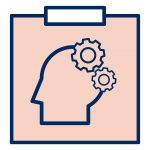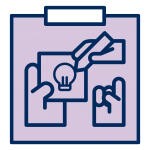Our Methods
Student experiences, like all human experiences, are diverse and complex. We need many lenses to understand them, so we draw inspiration from several methods, including:
- Design Thinking
- Integrative Thinking
- Ethnographic and Empathy-based Research
- Community-based and Collaborative Methodologies
- Equity and Anti-Oppressive Practices
Design Thinking

People solve problems to meet human needs. Yet too often, problem-solvers put on their technician hats (asking “What is feasible and viable?”) rather than their fellow-human ones (asking “How do people feel about this? What do they really want?”). Design thinking brings us back to the human, through empathy-based observations and interviews. It reminds us to fit design to human needs, rather than humans to design specifications.
Integrative Thinking

Tricky problems spawn multiple solutions. That’s a feature, not a bug. Rather than arguing about “either-or,” we can choose “both-and.” Integrative thinking challenges us to face seemingly conflicting ideas and take the best of each, to produce something different and better yet.
Ethnographic and Empathy-based Research

Ethnography is the study of how people live their lives. Ethnographers—usually anthropologists and sociologists—immerse themselves in the worlds of other people to see how their experiences are felt and created. We use the techniques they developed to delve into the hopes, fears, desires, and needs that underlie the student experience.
Community-Based & Collaborative Methodologies

Each person is an expert on their own life and experiences. By recognizing this expertise, designers and community organizers can enrich their ideas for community growth. We treat students as experts in the student experience, no matter their program or degree level, and empower them to connect with other students, faculty, and staff to improve life at UofT.
Equity & Anti-Oppressive Practices

Designing for all students means recognizing and including their diversity. We commit to equity, inclusivity, and accessibility. Our professional and volunteering opportunities are open to students from all backgrounds and at all stages of education. We provide equity and anti-oppression training for our team members, and we connect with communities to include diverse voices.
